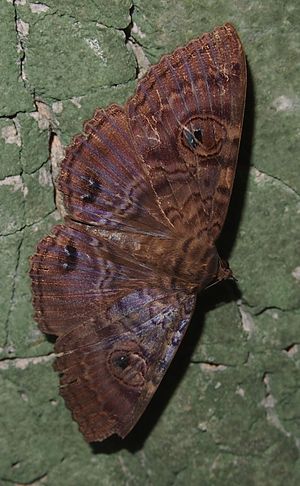Granny's cloak moth facts for kids
Quick facts for kids Granny's cloak moth |
|
|---|---|
 |
|
| Scientific classification | |
| Synonyms | |
|
The granny's cloak moth, also known by its scientific name Speiredonia spectans, is a fascinating insect. It belongs to a large group of moths called the Erebidae family. This amazing moth was first officially described by a scientist named Achille Guenée way back in 1852.
You can mostly find the granny's cloak moth flying around in north-eastern Australia and Tasmania. Sometimes, these moths travel far from home and have been spotted in places like Norfolk Island and even New Zealand! When fully grown, this moth has a wingspan of about 70 millimeters, which is roughly the length of a standard pencil.
Contents
About the Granny's Cloak Moth
The granny's cloak moth gets its common name from its appearance, which some people think looks like an old-fashioned cloak. Moths are often confused with butterflies, but they are different! Moths usually fly at night, have feathery antennae, and often rest with their wings flat. Butterflies, on the other hand, are usually active during the day, have club-tipped antennae, and rest with their wings upright.
Where They Live
These moths prefer warmer climates, which is why they are found in the northern parts of Australia. They live in various habitats, including forests and woodlands, where their food sources are plentiful. Their ability to travel long distances means they can sometimes appear in new areas, like the islands of Norfolk and New Zealand.
Life Cycle of the Moth
Like all moths and butterflies, the granny's cloak moth goes through a complete metamorphosis during its life. This means it changes a lot as it grows! It starts as an egg, then hatches into a larva (which is a caterpillar), then turns into a pupa, and finally emerges as a beautiful adult moth.
What Do They Eat?
The young moths, called larvae or caterpillars, have a very specific diet. They love to munch on the leaves of Acacia species. Acacia is a type of tree or shrub that is very common in Australia. The caterpillars eat these leaves to grow big and strong before they change into pupae and then into adult moths. Adult moths typically feed on nectar from flowers, but the main food for the growing larvae is the Acacia plant.
Gallery





